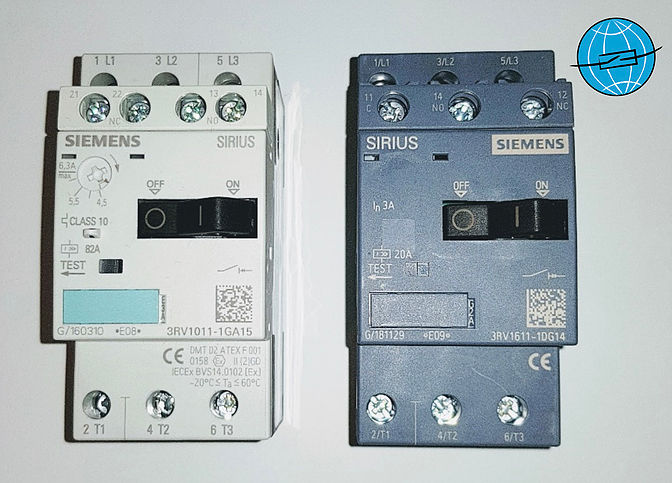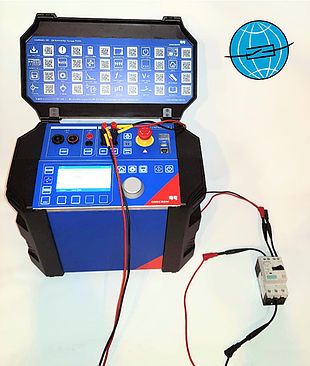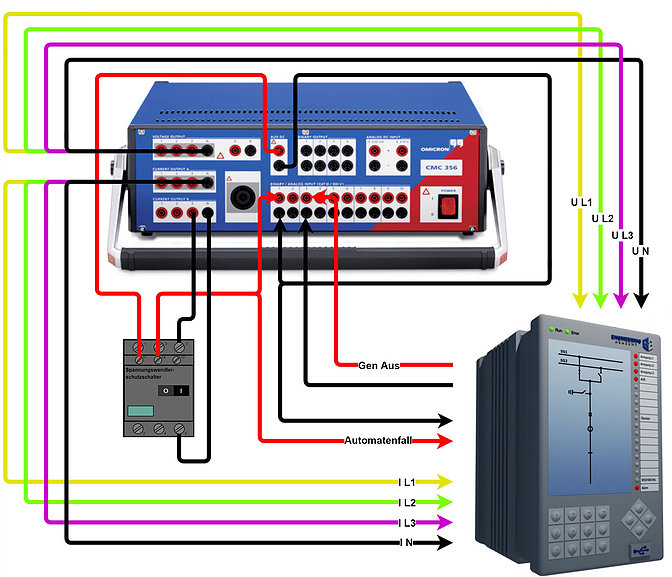HEARTfelt Welcome dear friends of protection and control engineering. In our exciting practical test, we made a discovery that made us speechless. In today's second part we are concerned with nothing less than the switching times of the auxiliary contacts of the MCB's. Read what we discovered.

Let's first of all imagine the following situation:
"As part of maintenance work, the voltage transformer circuit breaker for the power quality measurement should be switched off. Inadvertently, the assigned colleague switches off the circuit breaker of the distance protection relay. He suddenly realizes his mistake, as at the same time the 110 kV circuit breaker behind his back gives a loud bang.
What happened?
The protection device signals via its LEDs that the distance protection has triggered. The LED for the MCB trip also lights up. The auxiliary contact of the voltage converter was thus properly connected to the distance protection device. The distance protection would have to block and thus prevent a false triggering. So what went wrong?
The answer to this can be found directly on the mini circuit breaker. The auxiliary contacts have reported the already opened power contacts of the circuit breaker too late to the protection relay. As a result, the blocking of the distance protection function was no longer effective in time.
To prevent this from happening in practice there are special circuit breakers for voltage transformers. These are designed so that the auxiliary contacts and the main contacts work together optimally.

When the circuit breaker is switched on, the main contact is closed first. Only with a little delay then also switches the auxiliary contact. The protection device thus measures voltage again before the automatic event message disappears. When the machine is switched off, as in our scenario, the auxiliary contacts are activated first. The protection device can block the protection function. Only with some delay then the main contacts are opened.
At least that's the theoretical ideal case, but what about the practical test?
We protection engineers are skeptical people and quite a few control freaks. We want to know "it" for sure. How about the switching times of the auxiliary contacts?
Take a Siemens 3RV1611-1DG14 voltage transformer circuit breaker and an almost identical Siemens 3RV1011-1GA15 motor protection switch (or order it quickly) to compare them.

In a direct comparison, you immediately notice the difference in the fixed auxiliary contacts. The motor protection switch (left in the picture) has a normally closed contact (21/22) and a normally open (13/14) contact. The voltage transformer circuit breaker only one changeover contact (11/12/14). The motor protection switch also has an adjustable thermal release, but it should not bother us for the test. The rest is the same externally. Both switches also have the option of attaching additional auxiliary contacts laterally.

With a small test setup and using my beloved COMPANO 100, I measure the time offset between the main L2 contact and all auxiliary contacts.
Since you can operate the toggle switches slowly or quickly, I measure each switching direction with three different switching speeds and repeat this 5 times to average.
I start with the measurement of the normal motor protection switch ...

... and am horrified. I did not expect the switching times of the auxiliary contacts to be so intensely dependent on the manuell switching speed used. But far more consequential is the fact that the auxiliary contacts are exactly the opposite of what would be required for a functional blocking. Instead of starting with the auxiliary contact when switching off, the main contact is opened first. When switching on exactly the opposite problem occurs. Instead of first starting with the main contact, the auxiliary contact is first actuated. Again, it would come to a false trip. With good luck, the trip could be avoided with a very quick operation of the circuit breaker. At slow operation, the false trip is guaranteed!
Let's see if the special voltage converter circuit breaker performs better here.

A closer look at the measurement results makes it clear that the times of the auxiliary contacts have been optimized according to the information from the manufacturer's data sheet. The time offset between the main and auxiliary contact is correct. While we can expect a faulty performance in the normal motor circuit breaker and hope only with a very fast switching to avoid false tripping, the recommendation is at the special VT circuit breaker quietly switch a little slower. With this we are on the safe side and the relay can safely block and a possible false trip can be avoided.
Did I already say that we protection engineers want to know everything exactly?
In order to test our observations from the first and second part, I have set up a test setup with a Siemens 7SA611 distance protection relay, the type 3RV1611 motor protection switch and an Omicron CMC356 test device. The normal operation with rated current and rated voltage was simply simulated by the state sequencer. Another current output was connected to the main contacts of MCB. The auxiliary contact of the MCB was coupled into the protection device and into the CMC356, as well as the general unit of the protection device (see figure).

Protection relay in the picture is only an example
The following table shows the measurement results:

The distance protection tripped with each attempt. Since you could just omit the auxiliary contact of the circuit breaker, right?
No of course not!
A look at the setting parameters of the 7SA611 shows that it is possible in the protection device to store the reaction time of the circuit breaker. According to the data sheet of the manufacturer and based on my measurements, I set a reaction time of 10 ms in the protection device and repeat all measurements.

With the deposit of the reaction time, a functional behavior is established for the motor protection switch used. If the short-circuit current is sufficiently high, the protective function is expected to be blocked and there will be no undesired false tripping. It is also nice to see how important a high short-circuit current is for sufficiently fast tripping of the circuit breaker.
For the sake of completeness, it should be mentioned: Modern protection devices have additional integrated monitoring for the voltage transformer circuit. This means that it is not absolutely necessary to wire the auxiliary contacts of a circuit breaker to detect the tripping of the circuit breaker. I also activated this function with the protection relays and repeated the test. It showed that every mistake led to the blockade of the distance protection. Independent of the auxiliary contact of the circuit breaker. Even with larger 6 V and 15 A fault resistances, the algorithm reliably blocked.
Therefore it is recommended to always activate this function. But even if the algorithms for monitoring the measuring voltage are very sophisticated, we should not miss the classic auxiliary contact. Only the combination of both variants offers maximum reliability. A false trip in practice can cost a lot of money and should be avoided in any case.
Conclusion
The manual switching speed of a MCB is heavily involved in the timing sequence of the auxiliary contacts. The performance of a MCB should always be known and adapted to the given system configuration. Additional algorithms of modern digital protection relays should always be used in addition.
For questions, suggestions and opinions write us: info@electrical-engineering.academy





















